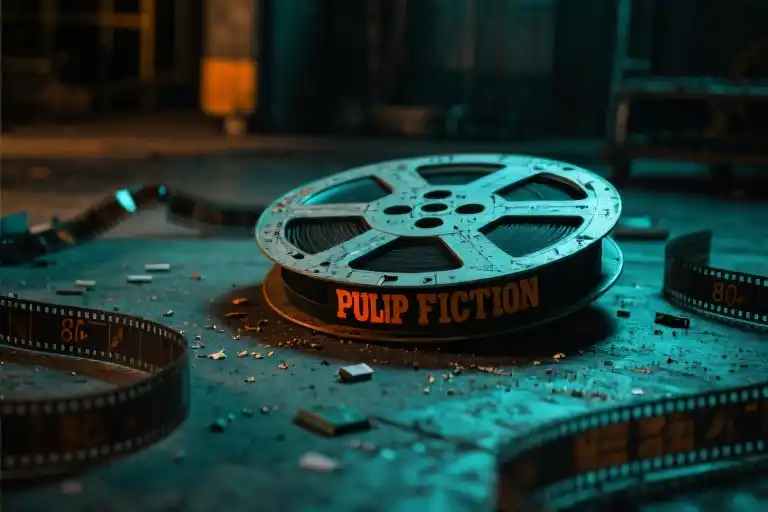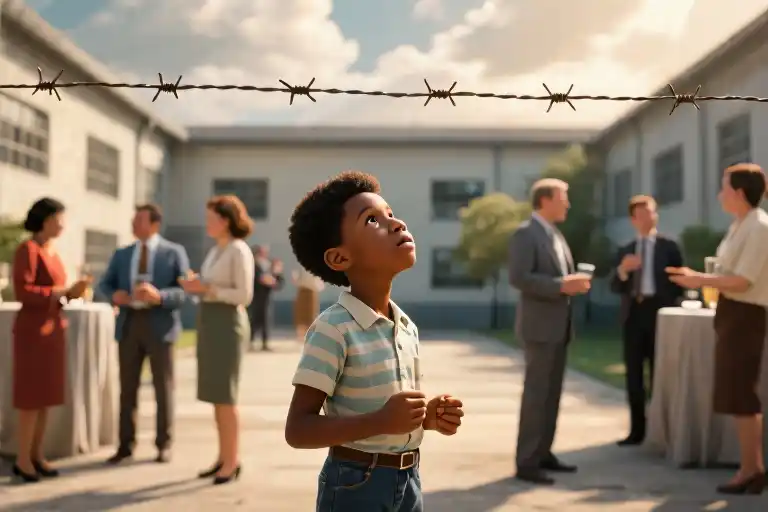There’s something deliciously meta about stealing Quentin Tarantino’s personal 35mm print of Pulp Fiction – a premise so audacious it practically sells itself in those mythical Hollywood elevator pitches. Yet Stealing Pulp Fiction, Danny Turkiewicz’s debut feature, serves as a cautionary tale about the vast chasm between high-concept allure and cinematic execution. What should have been a love letter to film geekery instead plays like a film school final project that forgot to budget for lighting equipment.
The film follows three misfits attempting to heist Tarantino’s prized possession, a setup brimming with potential for both satire and genuine pathos. Contemporary cinema has proven time and again that inventive premises can transcend modest budgets – Coherence turned dinner party physics into gripping drama with $50,000, while Tangerine shot entire scenes on iPhones without sacrificing visual punch. Turkiewicz’s concept arguably tops them for sheer cheekiness, which makes its fumbled delivery all more perplexing.
From the opening frames, the movie struggles with fundamental filmmaking choices. Scenes drown in murky shadows or harsh LED washes, the sort of lighting that makes actors look either like witness protection participants or department store mannequins. Cinematography oscillates between static shots that feel like security camera footage and chaotic handheld that suggests the operator was dodging imaginary gunfire. There’s an uncomfortable moment around the 23-minute mark where two characters debate the heist in a warehouse – the composition so awkward it appears the camera was placed by someone who’d only read about filmmaking in Wikipedia summaries.
What truly baffles isn’t the technical limitations – many great movies have overcome far worse – but the squandered opportunities within this premise. The idea of stealing physical film in our digital age could have sparked fascinating conversations about artistic value versus material worth. Instead, we get lazy homophobic gags that land with the subtlety of a dropped film canister, jokes that feel less like commentary and more like artifacts from a 1994 comedy draft someone forgot to update. References to Tarantino’s work appear randomly, neither clever homage nor purposeful deconstruction, just cinematic name-dropping without context.
Perhaps most telling is how the film inadvertently highlights the difference between ‘movies’ and ‘films’ – terms often used interchangeably, but carrying distinct connotations. Movies entertain; films aspire to art. Stealing Pulp Fiction manages neither, trapped in some purgatory where its concept suggests ambition its execution can’t support. Turkiewicz’s feature ultimately proves a painful truth: in cinema as in theft, the getaway matters just as much as the initial grab.
The Stolen Promise: When a High Concept Falters
The premise of Stealing Pulp Fiction sounds like something ripped straight from a late-night pitch session at Sundance: three misfits plotting to steal Quentin Tarantino’s personal 35mm print of Pulp Fiction. It’s the kind of concept that makes producers lean forward in their chairs – a self-aware meta-narrative about cinephile obsession, wrapped in a heist comedy package. On paper, it ticks all the boxes for indie success: built-in audience appeal (Tarantino fans), nostalgic film format fetishism (physical vs digital debates), and that sweet spot between homage and subversion.
Yet somewhere between that elevator pitch and the final cut, the magic leaked out like unspooled celluloid. The film becomes a case study in how even the most bulletproof concepts can misfire when execution stumbles. Consider how Edgar Wright’s Shaun of the Dead transformed a simple “zombies in London” premise into genre-defining work through meticulous visual storytelling and tonal control. Or how One Cut of the Dead turned its single-take gimmick into an emotional rollercoaster. These films understood that high concepts are merely diving boards – the real artistry happens in mid-air.
What makes the “stolen film print” idea particularly tantalizing is its layered symbolism. A physical 35mm copy represents more than just the movie itself; it’s a tangible piece of cinematic history, carrying the weight of projection booth scratches and the scent of aging acetate. The theft premise could have explored our cultural relationship with art ownership (who really “owns” a beloved film?), the black market for cinematic relics, or even the absurd lengths fans go to touch their idols. Instead, we get a series of half-baked sequences that treat the MacGuffin with all the reverence of a stolen bike.
Perhaps the greatest irony lies in how Stealing Pulp Fiction mirrors its own plot. Just as the characters fail to properly appreciate the treasure they’ve stolen, the filmmakers seem unaware of their concept’s true value. There’s a heartbreaking moment early on where one character holds the Pulp Fiction canister up to the light – a perfect opportunity to reflect on why we fetishize physical media, or how movies become personal talismans. The moment passes without insight, like so many others in this frustrating near-miss of a movie.
For aspiring filmmakers, there’s a crucial lesson here: concepts are currency, but direction is the economy. The most brilliant premise won’t save you if you can’t block a scene, if your lighting looks like a convenience store security camera, if your “homages” feel like someone shouting “Remember this part?” during sex. What separates a Clerks from a forgettable indie isn’t budget – it’s the understanding that every creative choice, from lens flare to line delivery, either serves the concept or betrays it.
When Technical Flaws Overshadow Ambition
The most generous thing one could say about Stealing Pulp Fiction‘s visual language is that it achieves a peculiar consistency – consistently underwhelming. What begins as a promising high-concept heist movie quickly reveals itself as a masterclass in how technical limitations can strangle creative potential.
The LUT Apocalypse
From the opening scene in a dimly lit pawn shop, the film suffers from what cinematographers call ‘LUT dependency syndrome’ – that telltale plasticine look when color grading becomes a crutch rather than a tool. Skin tones fluctuate between jaundiced yellow and corpse blue, while shadows crush details into oblivion. There’s a particularly egregious nighttime driving sequence (around the 37-minute mark) where the actors appear to be floating in a sea of teal-and-orange sludge, the dashboard lights glowing like radioactive elements.
This isn’t artistic stylization; it’s the visual equivalent of putting lipstick on a technical shortcoming. Proper lighting could have salvaged these scenes – a simple bounce board to fill shadows, or practical lights to establish motivated sources. Instead, we get the indie film trifecta of sins: underexposed footage ‘fixed’ in post, extreme contrast ratios masking poor composition, and color grades that change shot-to-shot.
The Static Camera Conundrum
Cinematography should serve the story, but here the camera feels like an afterthought – often literally. Multiple dialogue scenes play out in unbroken wide shots where actors drift in and out of frame like amateur theater performers unsure of their marks. The infamous warehouse confrontation (at 1:12:30) could have been tense, but the locked-off medium shot drains all energy from what should be the film’s climax.
The most baffling choices occur when Turkiewicz appears on screen as actor-director. In these moments, the framing becomes conspicuously narcissistic – his character always perfectly centered while others get awkwardly cropped. It creates an unintentional meta-narrative about creative myopia, where the filmmaker’s vanity overshadows the ensemble nature of the heist premise.
When Limitations Become Choices
Budget constraints explain some flaws, but not the refusal to work within them creatively. The Coen Brothers’ Blood Simple proved how limitations can birth innovation – their solution to a low lighting budget was to make darkness a stylistic feature. Here, the flat lighting and static compositions don’t feel like artistic statements, but surrender to inexperience.
A single Steadicam sequence (the pawn shop robbery at 18:45) shows fleeting promise, suggesting what might have been with more disciplined visual storytelling. But these moments drown in a sea of technical indifference, where every poorly executed scene whispers the same truth: no amount of clever premise can compensate for ignoring cinema’s visual grammar.
When Jokes and Homages Fall Flat
There’s a particular cringe that comes from watching a film strain to be edgy or referential, only to land with the grace of a dropped cafeteria tray. Stealing Pulp Fiction delivers this sensation in spades, particularly when it attempts two things many indie films stumble over: controversial humor and paying homage to its influences. Neither attempt works, and their failure speaks volumes about why execution matters more than intention.
The homophobic jokes scattered throughout feel less like deliberate provocations and more like artifacts from a 1990s stand-up routine someone forgot to edit out. In one painfully awkward scene, a character makes a prison soap joke that might have played as dark humor with proper context or character development. Instead, it hangs there, neither subversive nor clever, just uncomfortable. What’s baffling isn’t the presence of edgy humor – Tarantino’s own films prove controversial jokes can work – but the complete absence of purpose behind them. At least Pulp Fiction’s infamous gimp scene served the narrative’s themes of power and humiliation. Here, the jokes exist simply because someone thought they’d be ‘cool,’ demonstrating a fundamental misunderstanding of how transgressive humor functions.
References to Tarantino’s work suffer similar aimlessness. Where Kill Bill wove homages to martial arts films into its DNA, Stealing Pulp Fiction drops nods like a tourist tossing coins at landmarks – the Royale with Cheese mention feels obligatory, the trunk shot composition lacks any visual purpose. These aren’t loving tributes or clever subversions, just empty gestures proving the filmmakers understood what made Tarantino’s style distinctive without grasping why those choices worked. It’s the cinematic equivalent of quoting a famous philosopher in your term paper because it sounds smart, not because it advances your argument.
Perhaps most frustrating is how these missteps overshadow the film’s legitimate ambitions. The premise inherently engages with fan culture and artistic ownership – themes ripe for exploring through referential humor and stylistic borrowing. But without thoughtful execution, what could have been a meta-commentary on cinephilia becomes just another movie that mistakes recognition for depth, shock value for substance. For aspiring filmmakers, the lesson rings clear: influence should be a springboard, not a crutch, and provocation requires more courage than simply repeating tired stereotypes.
Survival Guide for Indie Filmmakers: How Not to Become a Cautionary Tale
The road to cinematic disaster is often paved with good intentions. For every breakout indie success like Paranormal Activity or Clerks, there are dozens of films like Stealing Pulp Fiction that serve as unintentional masterclasses in what not to do. Let’s break down the practical lessons from this misfire into actionable advice for emerging filmmakers.
Budget Allocation: Spend Where It Counts
That flickering warehouse scene where the characters plot their heist? The one that looks like it was lit with a single exposed bulb from Home Depot? It perfectly illustrates the first rule of indie filmmaking: your lighting budget is never negotiable. When working with limited resources, prioritize these elements in descending order:
- Lighting equipment – Aputure 300D kits may seem expensive until you compare them to the cost of reshooting poorly lit scenes
- Sound recording – Audiences will forgive mediocre visuals before tolerating muddy dialogue
- Camera stabilization – That shaky handheld look stopped being charming around 2005
- Production design – Viewers can smell empty rooms with no set dressing
- Talent fees – Name actors won’t save a technically flawed project
Notice what’s conspicuously absent from this list? Those Tarantino-esque tracking shots that require expensive steadicam operators. The hard truth is this – no one cares about your homage if they can’t see or hear your actors properly.
The Sensitivity Checklist: Three Questions Before Shooting
Remember those cringe-worthy homophobic jokes that added nothing to Stealing Pulp Fiction? They highlight why every script needs to pass this simple test before going into production:
- Does this serve the story? If removing the joke/comment/reference changes nothing about plot or character development, cut it
- Are we punching down? Humor at the expense of marginalized groups isn’t edgy – it’s lazy
- Would we say this to someone’s face? Imagine the subject of the joke in the room during playback
For those determined to include provocative humor, study how Tropic Thunder handled similar material – the satire had clear targets and consistent perspective. Random gay panic jokes in 2024 don’t shock audiences; they just make filmmakers look painfully out of touch.
High Concept Evaluation: The Reality Test
That “steal Tarantino’s print” premise probably sounded brilliant at 2am after three energy drinks. Before committing to any high-concept idea, run it through this filter:
- Can we actually execute this? (Be brutally honest about your team’s skills and resources)
- Does the concept carry its own weight? (Or does it rely entirely on references to better works)
- What’s the emotional core? (Snakes on a Plane worked because it embraced its ridiculousness completely)
The most damning thing about Stealing Pulp Fiction isn’t its technical flaws – it’s that beneath the gimmick, there’s no compelling reason for this story to exist. Contrast this with Once Upon a Time in Hollywood, where Tarantino’s love letter to a bygone era had genuine affection beneath the references.
At the end of the day, no amount of stolen film prints or name-dropping can compensate for a lack of authentic vision. The real theft here wasn’t from Tarantino’s vault – it was from audiences who deserved better than a half-baked concept masquerading as a movie.
The Final Verdict: Talent Can’t Be Stolen
The irony of Stealing Pulp Fiction isn’t lost on anyone who’s sat through its 97 minutes – you can swipe a physical film reel, but you can’t pilfer the creative spark that made the original iconic. This cinematic misfire serves as an accidental case study in how not to pay homage, with all the subtlety of a film student yelling “Look at my references!” during a midnight screening at Quentin Tarantino’s New Beverly Cinema.
What’s particularly tragic about this endeavor isn’t just the shoddy execution, but how it misunderstands what made Pulp Fiction revolutionary. Tarantino’s masterpiece worked because every technical choice – the lurid lighting, the prowling camera movements, the needle drops – served the storytelling. Turkiewicz’s version demonstrates what happens when references become cheap decorations rather than organic elements. Those awkward homophobic jokes? They’re not transgressive like Pulp Fiction’s edgy dialogue – they’re just uncomfortable, the kind of humor that dies in the room before reaching the microphone.
The film vs movie debate this unintentionally sparks is perhaps its only valuable contribution. True films (the kind Tarantino makes) create their own language, while mere movies (like this one) just regurgitate someone else’s vocabulary badly. There’s a telling moment when the characters actually handle the stolen Pulp Fiction print – the reverence they show that physical object contrasts painfully with how carelessly they treat its artistic legacy throughout the story.
For aspiring filmmakers watching this trainwreck, the lesson isn’t about avoiding ambition. It’s about understanding that great concepts need equal parts craft and self-awareness. The best meta-commentary on filmmaking here comes unintentionally – when these would-be thieves struggle to project their stolen treasure, it mirrors how the director struggles to project any coherent vision through his borrowed aesthetic.
So is Tarantino’s print safe? Probably more so than his reputation after being vaguely associated with this mess. The real crime wasn’t the fictional theft – it was wasting a perfectly good premise that could’ve explored cinephilia, obsession and artistic ownership in clever ways. Instead we got proof that between a high concept and a great movie falls the shadow of poor execution – a shadow this film can’t even light properly.



